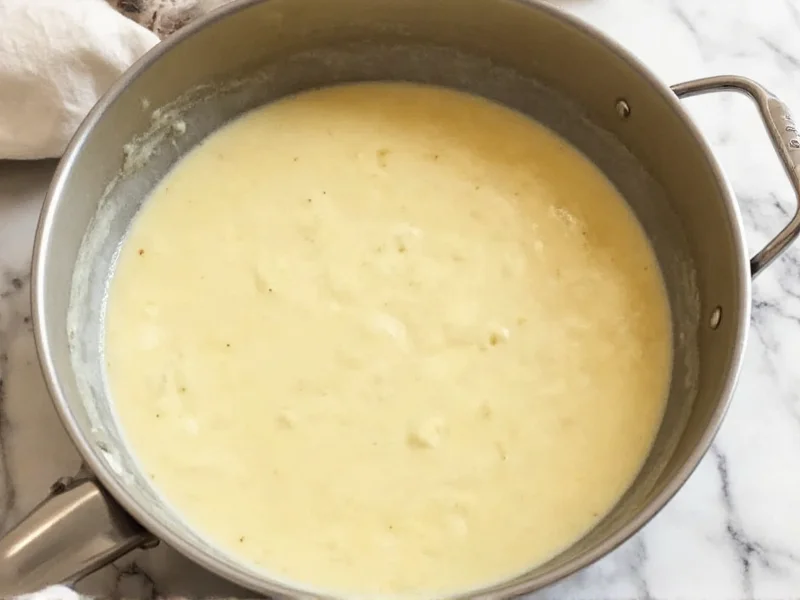If your alfredo sauce has turned out thinner than expected, don't panic. This common kitchen issue has multiple reliable solutions that won't compromise your dish's flavor. Understanding why alfredo sauce thins and knowing the proper thickening techniques can rescue your meal and improve your future sauce-making skills.
Why Alfredo Sauce Becomes Too Thin
Alfredo sauce thins for several reasons: adding pasta water that's too starchy, using pre-grated cheese with anti-caking agents, incorporating too much liquid from ingredients, or not reducing the sauce sufficiently. The emulsion can also break if the temperature is too high, causing separation and thinning. Recognizing these causes helps prevent future issues when learning how to get alfredo sauce to thicken properly.
The Science Behind Sauce Thickening
Alfredo sauce relies on emulsification—combining fat (butter, cream) and water-based elements. When this balance shifts, the sauce thins. Thickening works by either:
- Reducing water content through simmering
- Adding ingredients that bind with liquid
- Creating new emulsions that stabilize the mixture
Unlike tomato-based sauces that use tomatoes' natural pectin, alfredo lacks built-in thickeners, making understanding how to thicken alfredo sauce without flour essential for authentic results.
Most Effective Thickening Methods
1. Simmering and Reduction
The purest method requires no additional ingredients. Gently simmer your sauce uncovered for 5-10 minutes, stirring frequently. As water evaporates, the sauce naturally concentrates. This technique preserves flavor while addressing why is my alfredo sauce too thin. Never boil vigorously, as this can cause separation.
2. Freshly Grated Parmesan Boost
Pre-grated cheese contains starches that prevent proper melting. For immediate thickening, whisk in ¼ cup freshly grated parmesan per cup of sauce. The cheese's natural fats and proteins bind with the liquid. This method answers how to thicken alfredo sauce with cheese while enhancing flavor—ideal for fixing watery alfredo sauce without altering taste.
3. Cheese Slurry Technique
Create a smooth thickener by mixing 2 tablespoons grated parmesan with 1 tablespoon softened cream cheese. Whisk this paste into warm (not boiling) sauce. The cream cheese's stabilizers prevent clumping while the cheese adds body. This professional approach solves how to make alfredo sauce thicker without changing flavor.
| Thickening Method | Time Required | Flavor Impact | Best For |
|---|---|---|---|
| Simmering/Reduction | 5-10 minutes | Concentrates flavor | Minor thinning issues |
| Fresh Parmesan Addition | 2-3 minutes | Enhances cheesiness | Moderate thinning |
| Cheese Slurry | 3-5 minutes | Richer texture | Severely thin sauce |
| Cornstarch Slurry | 1-2 minutes | Neutral | Quick fixes |
4. Cornstarch Slurry (For Immediate Results)
When time is critical, this method provides the quickest fix for runny alfredo sauce. Mix 1 tablespoon cornstarch with 1 tablespoon cold water until smooth. While sauce simmers gently, slowly whisk in the slurry. Continue cooking for 1-2 minutes until thickened. Use sparingly—too much creates an artificial texture. This approach works well for thickening store-bought alfredo sauce that's overly thin.
Methods to Avoid
Certain approaches seem logical but create worse problems:
- Adding flour directly—creates lumps and raw flour taste
- Excessive heat—causes separation and oiliness
- Using pre-shredded cheese—contains anti-caking agents that prevent proper melting
- Adding cold ingredients—shocks the emulsion causing breakage
Troubleshooting Common Issues
If Sauce Separates During Thickening
Remove from heat immediately. Whisk in 1-2 tablespoons warm cream or pasta water while slowly returning to low heat. The added liquid helps re-emulsify the fats and proteins. This technique often resolves issues when attempting how to thicken alfredo sauce while cooking.
If Sauce Becomes Too Thick
Gradually whisk in small amounts of warm cream, milk, or reserved pasta water until desired consistency returns. Add liquid slowly—a little goes a long way. This correction method maintains the sauce's integrity after over-thickening.
Prevention Tips for Perfect Alfredo Every Time
Avoid thin sauce problems with these professional techniques:
- Use freshly grated high-quality parmesan (Parmigiano-Reggiano)
- Maintain low-to-medium heat—never let sauce boil
- Add cheese gradually while whisking constantly
- Reserve ½ cup pasta water before draining
- Finish sauce in the pan with cooked pasta to absorb excess moisture
Understanding these principles transforms how to get alfredo sauce to thicken from a problem-solving exercise into a reliable skill. With practice, you'll consistently create restaurant-quality alfredo with perfect texture.











 浙公网安备
33010002000092号
浙公网安备
33010002000092号 浙B2-20120091-4
浙B2-20120091-4